
The Umayyad Caliphate(Pronounced variously, ; Arabic: ٱلْخِلَافَة ٱلْأُمَوِيَّة, romanized: al-Khilāfah al-ʾUmawīyah) or Umayyad Empire was the second caliphate established after the death of the Islamic prophet Muhammad. The caliphate was ruled by the Umayyad dynasty, also known as the Umayyads. Uthman ibn Affan, the third of the Rashidun caliphs, was also a member of the clan. The family established dynastic, hereditary rule with Muawiya ibn Abi Sufyan, long-time governor of Greater Syria, who became caliph after the end of the First Fitna in 661. After Mu'awiya's death in 680, conflicts over the succession resulted in the Second Fitna, and power eventually fell to Marwan I, from another branch of the clan. Syria remained the Umayyads' main power base thereafter, with Damascus as their capital.
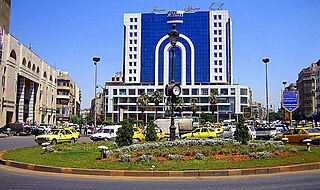
Homs, known in pre-Islamic Syria as Emesa, is a city in western Syria and the capital of the Homs Governorate. It is 501 metres (1,644 ft) above sea level and is located 162 kilometres (101 mi) north of Damascus. Located on the Orontes River, Homs is also the central link between the interior cities and the Mediterranean coast.

The Ghassanids (Arabic: الغساسنة, romanized: al-Ġasāsina, also Banu Ghassān, also called the Jafnids, were an Arab tribe which founded a kingdom which was in place from the third century to the seventh century in the area of the Levant and northern Arabia. They emigrated from South Arabia in the early third century to the Levant. Some merged with Hellenized Christian communities, converting to Christianity in the first few centuries, while others may have already been Christians before emigrating north to escape religious persecution.
ʿĀmir ibn ʿAbd Allāh ibn al-Jarrāḥ, better known as Abū ʿUbayda was a Muslim commander and one of the Companions of the Islamic prophet Muhammad. He is mostly known for being one of the ten to whom Paradise was promised. He remained commander of a large section of the Rashidun Army during the time of the Rashid Caliph Umar and was on the list of Umar's appointed successors to the Rashidun Caliphate but died before Umar did.

Shaizar or Shayzar is a town in northern Syria, administratively part of the Hama Governorate, located northwest of Hama. Nearby localities include, Mahardah, Tremseh, Kafr Hud, Khunayzir and Halfaya. According to the Syria Central Bureau of Statistics (CBS), Shaizar had a population of 5,953 in the 2004 census.

Qasr Ibn Wardan is a hamlet and 6th-century archaeological site located in the Syrian Desert, approximately 60 kilometres (37 mi) northeast from Hama and about 19 kilometres (12 mi) northeast of al-Hamraa. The hamlet is separated from the Byzantine-era ruins by a road, with the former situated to the east of the road and the ruins situated to the west. According to the Syria Central Bureau of Statistics (CBS), Qasr Ibn Wardan had a population of 467 in the 2004 census.

Salamieh (Arabic: سلمية Salamieh) is a city and district in western Syria, in the Hama Governorate. It is located 33 kilometres southeast of Hama, 45 kilometres northeast of Homs. The city is nicknamed the "mother of Cairo" because it was the birthplace of the second Fatimid caliph al-Qa'im bi-Amr Allah, whose dynasty would eventually establish the city of Cairo, and the early headquarters of his father Abdullah al-Mahdi Billah who founded the Fatimid Caliphate. The city is an important center of the Shi'ite Nizari Isma'ili and Taiyabi Isma'ili Islamic schools and also the birthplace of poet Muhammad al-Maghut. The population of the city is 66,724.
The Banu Kalb was an Arab tribe which mainly dwelt in the desert and steppe of northwestern Arabia and central Syria. It was involved in the tribal politics of the Byzantine Empire's eastern frontiers, possibly as early as the 4th century. By the 6th century, the Kalb had largely adopted Christianity and came under the authority of the Ghassanids, leaders of the Byzantines' Arab allies. During the lifetime of the Islamic prophet Muhammad, a few of his close companions were Kalbites, most prominently Zayd ibn Haritha and Dihya, but the bulk of the tribe remained Christian at the time of Muhammad's death in 632. They began converting in large numbers when the Muslims made significant progress in the conquest of Byzantine Syria, in which the Kalb stayed neutral. As a massive nomadic tribe with considerable military experience, the Kalb was sought as a key ally by the Muslim state. The leading clans of the Kalb forged marital ties with the Umayyad family, and the tribe became the military foundation of the Syria-based Umayyad Caliphate (661–750) from the reign of Mu'awiya I to the early reign of Abd al-Malik.
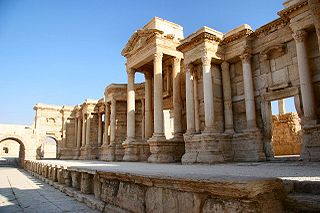
The Muslim conquest of the Levant, or Arab conquest of Syria, was a 634–638 CE invasion of Byzantine Syria by the Rashidun Caliphate. A part of the wider Arab-Byzantine Wars, the Levant was brought under Arab Muslim rule and developed into the provincial region of Bilad al-Sham. Clashes between the Arabs and Byzantines on the southern Levantine borders of the Byzantine Empire had occurred during the lifetime of Muhammad, with the Battle of Muʿtah in 629 CE. However, the actual conquest did not begin until 634, two years after Muhammad's death. It was led by the first two Rashidun caliphs who succeeded Muhammad: Abu Bakr and Umar ibn al-Khattab. During this time, Khalid ibn al-Walid was the most important leader of the Rashidun army.
The Tayy, also known as Ṭayyi, Tayyaye, or Taiyaye, are a large and ancient Arab tribe, among whose descendants today are the tribes of Bani Sakher and Shammar. The nisba (patronymic) of Tayy is aṭ-Ṭāʾī (ٱلطَّائِي). In the second century CE, they migrated to the northern Arabian ranges of the Shammar and Salma Mountains, which then collectively became known as the Jabal Tayy, and later Jabal Shammar. The latter continues to be the traditional homeland of the tribe until the present day. They later established relations with the Sasanian and Byzantine empires.

Qasr al-Hayr al-Sharqi is a castle (qasr) in the middle of the Syrian Desert. It was built by the Umayyad caliph Hisham ibn Abd al-Malik in 728-29 CE in an area rich in desert fauna. It was apparently used as a military and hunting outpost. The palace is the counterpart of Qasr al-Hayr al-Gharbi, a nearby castle palace built one year earlier. It is one of the so-called desert castles.

Qasr al-Hayr al-Gharbi is a Syrian desert castle or qasr located 80 km south-west of Palmyra on the Damascus road. The castle is a twin palace of Qasr al-Hayr al-Sharqi, built by the Umayyad caliph Hisham ibn Abd al-Malik in 727 CE. It was built in the Umayyad architectural style.
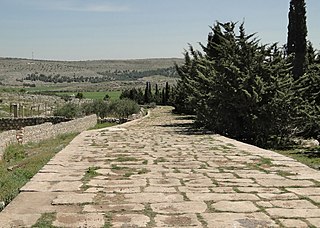
Qinnašrīn, was a historical town in northern Syria. The town was situated 25 km (16 mi) southwest of Aleppo on the west bank of the Queiq and was connected to Aleppo with a major road during Roman times.
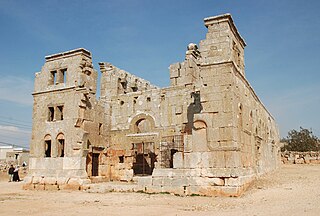
Qalb Loze is a Druze village in northwestern Syria, administratively part of the Idlib Governorate located about 35 kilometres (22 mi) west of Aleppo. It is situated near the border with Turkey, in the A'la Mountain and is part of an area known as the "Dead Cities". According to the Syria Central Bureau of Statistics (CBS), Qalb Loze had a population of 1,290 in the 2004 census.
Khalid ibn al-Walid ibn al-Mughira al-Makhzumi was a 7th-century Arab military commander. He initially headed campaigns against Muhammad on behalf of the Quraysh. He later became a Muslim and spent the remainder of his career in service to Muhammad and the first two Rashidun caliphs: Abu Bakr and Umar. Khalid played the leading command roles in the Ridda Wars against rebel tribes in Arabia in 632–633, the initial campaigns in Sasanian Iraq in 633–634, and the conquest of Byzantine Syria in 634–638.
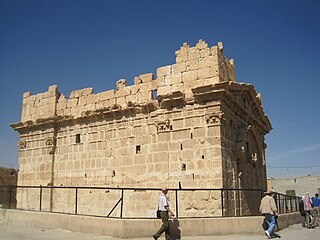
Dumeir, also Dumair, Damir and Dumayr is a city located 45 kilometers north-east of Damascus, Syria.

Furqlus is a town in central Syria, administratively part of the Homs Governorate, east of the city of Homs. Situated at the eastern approaches of the Syrian Desert, the town is located between al-Qaryatayn to the south, Sadad to the southwest, Shinshar to the west, Fatim al-Amuq and al-Sayyid to the northwest, al-Mukharram to the north and Palmyra to the east. According to the Central Bureau of Statistics (CBS), Furqlus had a population of 5,096 in the 2004 census.
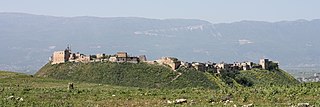
Qalaat al-Madiq is a town and medieval fortress in northwestern Syria, administratively part of the Hama Governorate, located northeast of Hama. It is situated in the al-Ghab plain, on the eastern bank of the Orontes River. Nearby localities include the district center al-Suqaylabiyah to the south, Bureij and Karnaz to the southeast, Kafr Nabudah to the east, al-Huwash to the north, Huwayjah al-Sallah and Shathah to the northwest and Al-Tuwayni and Ennab to the west. According to the Syria Central Bureau of Statistics (CBS), Qalaat al-Madiq had a population of 12,925 in the 2004 census. It is the administrative center and second largest locality in the Qalaat al-Madiq nahiyah ("subdistrict") which consisted of 40 localities with a collective population of 85,597 in 2004. The town's inhabitants are predominantly Sunni Muslims.
The Jarrahids were an Arab dynasty that intermittently ruled Palestine and controlled Transjordan and northern Arabia in the late 10th and early 11th centuries. They were described by historian Marius Canard (1888–1982) as a significant player in the Byzantine–Fatimid wars in Syria who "created for themselves, in their own best interests, a rule of duplicity, treason and pillage". They were the ruling family of the Tayy tribe, one of the three powerful tribes of Syria at the time; the other two were Kalb and Kilab.

The Khalid ibn al-Walid Army was an armed Salafi jihadist group active in southern Syria. It was formed by a merger of the Yarmouk Martyrs Brigade, the Islamic Muthanna Movement, and the Army of Jihad on 21 May 2016. The faction controlled a strip of territory southeast of the Golan Heights, and was in conflict with other forces of the Syrian rebels. The group was defeated and lost all of its territory to the Syrian Government on 31 July 2018, with many members surrendering. Many captured members of the Khalid Bin Walid Army were executed on the same day.
















